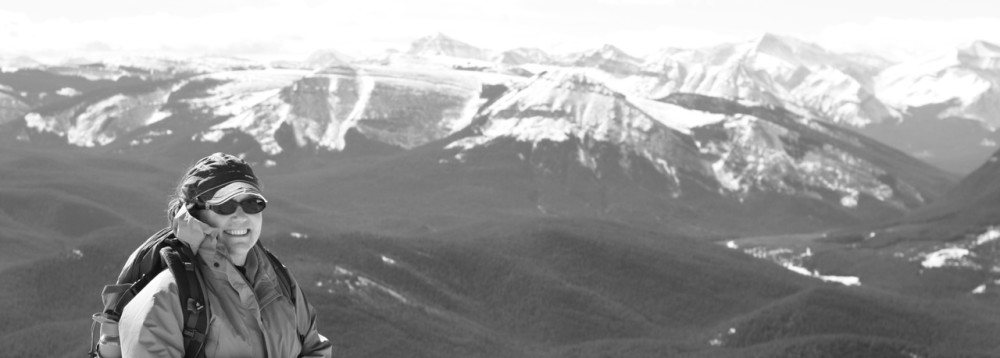I should have paid closer attention to the details.
We shouldered our backpacks in the Elbow Lake parking lot on Highway 40 in Peter Lougheed Provincial Park, Alberta, and joined the day hikers heading for Rae Glacier and the young families traipsing up to the lake. The short 1.3 km uphill was quickly covered and we left most of the crowd behind to head out alongside the headwaters of the Elbow River towards the Piper Meadows turnoff at 3.8 km from the lake.
Looking at the topographic map, we saw the “shortcut” across the meadows. The main turnoff was less than a km down the trail, but why go downhill, just to climb back up again? Why not take the direct route and save a little time and effort?
You know where this is going, right?
After a little cursing and more bushwhacking, we came up on the trail. No time or effort saved; probably the reason Gillean Daffern didn’t mention the “shortcut” in her guidebook. Happy to have a trail once again under our feet, we ambled through the forest, steadily climbing to Piper Meadows in full bloom.
A single Bighorn sheep skittered off to the scree slopes as we entered the meadows and old bear diggings marked the search for juicy roots as we got closer to the pass. What looked like uniform, fine brown dirt from a distance turned out to be slippery and steep scree up to the pass. The views back towards Rae Glacier took some of the sting out of the effort.
Layers, snacks and drinks took precedence at the pass (5 km from the Big Elbow trail junction). Piper Pass was named in honour of Norma Piper, an opera singer who married local legend George Pocaterra in the 1930s.
Looking over the other side towards the small tarn that was our original destination for the evening, I almost gasped at the faint trail – I swear made by the shaggy sheep that was looking up curiously at us. Had I been paying closer attention earlier, I might have heard “cliffs and vertiginous scree slopes” and “for experienced scree bashers and route-finders only.”

The descent off Piper Pass is challenging with loose scree and next to no trail. (Photo: Megan Kopp)
Ankles and knees still operating at almost full capacity, we stopped at the tarn and assessed the weather. The warm, sunny summer’s day was turning cloudy and without a doubt a storm was going to hit. The small alpine meadows offered little protection and we agreed it would be best to head for the shelter trees near the valley bottom. This is where it turned ugly… the route that is, not the surroundings!
Side-hilling across grassy meadows on the right and descending through some blocky scree we eventually reached the avalanche paths mentioned in the guide, hoping to see a sign of a trail. There really wasn’t one. Pushing on in the direction we knew we had to go, we bashed through the trees and finally found a bit of a route… oh, lost it… there it is… no, it’s gone again.

Finally on the “trail” – the West Fork of the Little Elbow is a test of route finding skills. (Photo: Brad Kopp)
By the time we reached the small canyon, a fairly well-defined trail led us down to an old hunter’s campsite beneath a towering ribbon waterfall. Perfect place to pitch a tent and hang a cooking tarp – all accomplished just before the rain set in for the night.
The problem with rainy nights and bushy trails is that no matter how waterproof your boots are or how high the gaiters rise, you are going to get wet. Especially when the trail disappears from time to time beneath the ravages of the 2013 floods. We kept heading downstream and angled across the wide meadows until we intersected the trail.
At this point, I’m really not sure why I bothered taking off my boots for the first of four creek crossings for the day, but damp is different than soaking wet. On the creek bank, fresh wolf tracks were spotted in the mud.
It was a challenging 3.5 km from our camp to the end of the exploration road where the route heads up to Paradise Pass. With clouds threatening, we made a hasty route change and opted for the easier hike 4.9 km down to Romulus Campground, up towards Tombstone Pass and back around to Elbow Lake rather than heading over Paradise and out Evan-Thomas as originally planned.
Spending another night down the trail from the pass, we took the side route in the morning into Tombstone Lakes. So close to Piper Pass and yet, so far.
Yes, I probably should have paid closer attention to the route details before heading out on this adventure, but if I had, I might have objected and missed the chance to circumnavigate Tombstone Mountain – and the opportunity to savour this little slice of heaven.
Total distance travelled: ~39 km
Guidebook: Daffern, Gillean. Kananaskis Country Trail Guide, Volume 2, 4th ed. Rocky Mountain Books, 2011.


































